Hard work by V.V. Vereshchagin, Russian battle-painter
Study Comprehension mastery
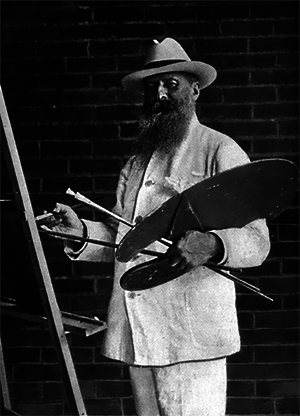
The future artist was born on October 14 1842, in Cherepovets, Novgorod Province. His parents were middle-class landowners who lived on the estate. The family was large. Vasily had three brothers, and, like many offspring of poor noble families, his father assigned his children to military schools. In 8, the boy was given to the Alexander Cadet Corps, and later on to the St. Petersburg Marine Corps. Being diligent, capable and ambitious, Vereshchagin set himself a goal not to fool around with regard to science and education, but to be among the best. In 1858 – 1859 on the training frigate "Kamchatka" among other pupils made educational trips to England, France and Denmark. The marine hull he finishes at 1860 with distinction, gaining the highest score possible, and is produced in midshipmen.
During this period of his life, a young military man, to put it in marine terms, makes a tack and changes its direction. Ever since childhood, Vereshchagin is fond of painting, and while studying at the Marine Corps, from 1858 he regularly attends the drawing school of the Society for the Encouragement of Artists, where he showed impressive results for a beginner. It was here that the cadet formed the idea to prefer the artistic field to a military career. He is going to leave the service and enter the Academy of Arts. Such a decisive step caused some confusion among parents, to put it mildly. The father, the leader of the nobility, unequivocally threatened his son with the imposition of strict economic sanctions, that is, as it was said then, “to deprive of funds”. Mother appealed to the moral side of the case, stressing that the representative of the old noble family should not engage in some kind of "frivolous arts". Another in his place would have thought hard - in such young years, dependence on his paternal homeland is still felt very keenly, but Vereshchagin has already made a decision, he was firm in them. Perhaps in his face Russia has lost a good naval officer, but it has acquired an excellent artist. The Maritime Department also did not want to lose the best graduate of the Marine Corps, but he was persistent and consistent.
In the 1860 year, without serving a year, Vereshchagin retires and becomes a student of the Academy of Arts. The father did not throw words to the wind, and the son was in a rather difficult financial situation, and even in the capital. The leadership of the Academy, I must give him his due, went towards the persistent and talented young man and gave him a small scholarship that allowed him to live and study, though very modestly. Creativity gained momentum - his work was marked by awards and incentives. In the process of comprehending the art of painting, the aspiring artist became increasingly confronted with the limitations to creativity. In the works, students were recommended to refer to the mythological plots of the ancient period. Vereshchagin, who was realistic and natural, was more and more closely in this very narrow and strict channel. And Vasily Vasilyevich would have been just a good draftsman of portraits of stately princes and rosy landowners, if not for his complicated character. Relations with the artistic authorities are not easy and continue to deteriorate. In the end, in 1863, Vereshchagin leaves the Academy of Arts and goes to the Caucasus to paint pictures from life, making wide use of local color for inspiration. He reached Tiflis along the Georgian Military Highway, where he spent more than a year. In fact, it was the life of a free artist - drawing lessons and customized drawings were a source of income. Realizing that he still lacks mastery, Vereshchagin worked at that time with more pencil, not oil paints.
Just then, the artist inherits from the deceased uncle, and he, unlike many nobles, decides to invest it in further education. Vereshchagin goes to Paris, where he enters the local Academy of Arts, training with the famous master J. L. Jerome. There he studies the technique of working with oil paints. But here, too, Vereshchagin was confronted, in his opinion, with an excessive enthusiasm for classicism - Jerome constantly recommended him to redraw paintings of famous classics of European painting. Vereshchagin, to realism and work from life, he, like in Petersburg, felt himself locked in some kind of framework. In March, 1865 r. He returns to the Caucasus, where he has been working intensively for six months. The young man made money, and it was now possible to put the Parisian experience into practice. In the autumn of 1865, Mr. Vereshchagin returned to Paris, where his Caucasian achievements made the most favorable impression on the teachers of the Academy. He continued his studies. He worked on 14 – 15 hours a day, without being tempted to visit theaters and other places of entertainment. In the spring of 1866, Vereshchagin returned to his homeland. So ended his training.
Turkistan
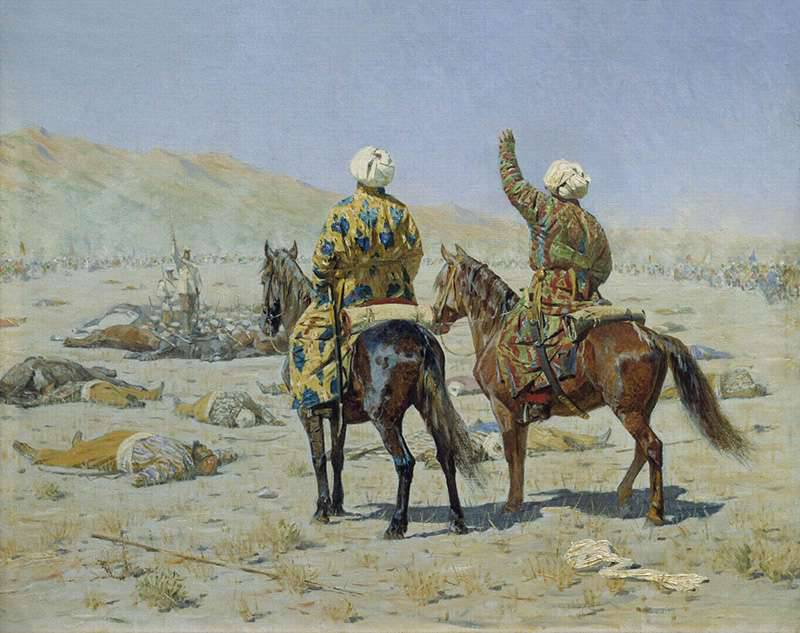
In the near future, Vereshchagin spends on the estate of his late uncle. The artist, who has spent his time studying and traveling, becomes sparse with money, so he is interrupted by odd jobs and portraits to order. The proposal that came unexpectedly from the Turkestan Governor-General Karl Petrovich von Kaufman to the artist had to be with him by the way. Vereshchagin was defined as an ensign with the right to wear civilian clothes and free movement. In August, 1867 of the year begins its long journey to Central Asia. Vereshchagin arrived in Samarkand 2 on May 1868 of the year, the day after he was taken by Russian troops. It was then that the position of Russia in Central Asia was consolidated, where until recently there were archaic feudal despotisms, the largest of which were the Kokand and Khiva khanates and the Bukhara emirate. One of the ways of existence of these state entities was an active slave trade, including Russian prisoners. Neighborhood with a specific understanding of diplomacy bai was a troublesome, and also unsafe - cases of raids on the southern borders of the empire were not infrequent, it is more appropriate to say regular. The emir of Bukhara behaved with emphatic arrogance - not only demanded that Russia withdraw its troops from Central Asia and confiscated the property of all Russian merchants, but also insulted a diplomatic mission that arrived to resolve the conflict. Soon there was an expected gap, which gradually flowed into hostilities.
1 May 1868 of the year under Samarkand The 3,5-thousandth Russian expeditionary detachment under the command of Kaufman dispersed almost 25-thousandth Bukhara army, taking trophies (21 gun and a lot of guns). 2 May city opened its gates. Since the emir himself successfully escaped, and several large detachments of Bukharians were operating nearby, 30 May Kaufman left Samarkand with the main forces, leaving a small garrison in the city. Four infantry companies, a company of sappers, two field guns and two mortars remained in the city. Total 658 people. Vereshchagin, absorbed in the study of one of the most ancient centers of Asia and inspired by amazing views of buildings, remained with a garrison commanded by Major Shtempel. While the artist was writing from life a generous oriental flavor, the mullahs and other agitators did not waste time in vain. Seeing that few Russians remained, they began to incite the local population to revolt, relying on the weakness and smallness of the garrison.
On the morning of June 1, crowds began to gather at the local bazaar and made fiery speeches. Stones flew from the roofs into the soldiers, and it became unsafe to move around the city. Realizing that the available forces are not enough to keep control of all of Samarkand, Stamp orders to retreat to the citadel. Russian merchants hid there too. By the morning of June 2, unrest swept over the entire city, and soon a large crowd came to storm the citadel. The attackers were armed and actively tried to break through the perimeter of the walls. They managed to set fire to one of the gates with gunpowder pots and then make a gap in them. Further advance of the rioters stopped such a serious obstacle as a cannon mounted on a direct lead and running with a quick fire with a canister directly over the breach. Continuous attacks lasted all day and stopped only at nightfall. Given the very difficult situation in which the besieged were, Stamp sent a messenger to Kaufman for help. The messenger for the sake of persuasiveness dressed the beggar, and he managed to slip out of the citadel unnoticed.
The next day, the attacks resumed with the same force. The besieged began to prepare the palace, located in the citadel, for the last line of defense. By common agreement, there could be no question of any surrender - at the very least, it was decided to blow up the palace and die with the attackers. For this purpose, almost the entire stock of gunpowder was transferred there. The wounded and sick did not leave their positions - there were many soldiers and officers among the garrison, for health reasons or because of the injury who were unable to make foot marches. Now they took the most effective part in the defense. The attacks continued on 4, 5 and 6 of June, albeit with less intensity. A handful of defenders was too tough for a huge, but insufficiently organized crowd, and its enthusiasm, which met such an insurmountable obstacle, began to cool. 7 June, a messenger made his way to the citadel, who, to the great joy of the defenders, said that Kaufman was going to the rescue by a forced march. 8 June Russian troops entered Samarkand and finally dispersed the enemy. The garrison lost about a third of its personnel.
Repressions against the local population were limited to the burning of the city bazaar, as a place of insurrection. Vereshchagin, who took the most effective part in the defense of the citadel, and not with an easel and brush in his hands, 14 August 1868 of the year for courage and bravery shown during the siege, was awarded the Order of St. George 4 degree, which he was proud of until the end of his life . So the baptism of Vereshchagin took place, which influenced not only his character, but also his work. In 1869, in St. Petersburg, with the assistance of Kaufman, who arrived there as part of a comprehensive exhibition dedicated to Turkestan, where samples of flora and fauna, minerals, household items and antiques were shown, some of the artist’s drawings and sketches were shown. This event was a success, and the name Vereshchagin flashed in the newspapers. After the exhibition is closed, the artist again, through Siberia, returns to Turkestan. Settling in Tashkent, Vereshchagin travels a lot: he visited Kokand, again visited Samarkand. Several times, being in the composition of small cavalry units, he was attacked by brigands, invariably demonstrating that he had good command of not only the brush, but also weapons. Eyewitnesses recalled that Vereshchagin always behaved bravely and was not timid.
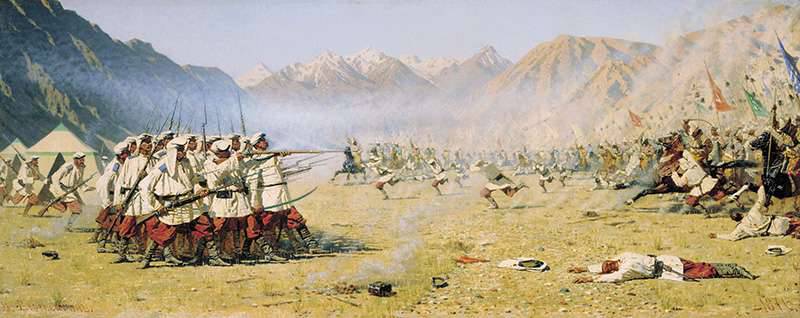
Traveling through Central Asia gave a lot of creative material that needed to be processed. Having settled at the beginning of 1871 in Munich, he began a large series of paintings dedicated to his stay in Turkestan. Vereshchagin worked tirelessly. Among others, he creates his famous series “Varvara”, consisting of seven canvases dedicated to the hostilities of the Russian army in Turkestan (“Look out for”, “Attack by surprise” and others). In the same year, 1871, under the impression of the legends about Tamerlane, the artist creates one of his most famous canvases - “The Apotheosis of War” - depicting a pile of skulls. Few were admitted to his Munich workshop. One of the first who saw first-hand the new paintings was the famous Russian merchant and patron of the arts, the founder of the gallery V. I. Tretyakov. They made a strong impression on the collector, and he offers to buy them. However, the author did not just want to sell his work profitably, but he certainly wanted to show it to the public. In 1873 in the Crystal Palace in London, Vereshchagin opens his first solo exhibition. The catalogs specifically indicated that the paintings were not for sale, and this only increased the interest of the public. The exhibition was a success - the paintings were striking in their realism.
In the spring of 1874, it took place in Petersburg. Wishing to make the visit as accessible as possible even to the poorer segments of the population, Vereshchagin arranged for several days a week to enter the exhibition free of charge. Her catalog was worth five kopecks. If the public enthusiastically met the works of the artist (for example, the composer M. P. Mussorgsky composed even the ballad “Forgotten” on the plot of the same name), then the entourage of Emperor Alexander II and some of the generals had a different opinion on this matter. Vereshchagin was accused of anti-patriotic, defeatist sentiment, that he impartially portrays Russian soldiers, showing them not with pathos winners, but “dead and vanquished.” Vereshchagin painted the war for what it is: without a dapper full uniform, and not everyone liked it. Death, blood and dirt, and not the academic ideal "Napoleon on Arkolsky Bridge" - that was what was in the works of the artist. The corresponding campaign in the press has begun: they say that such an interpretation humiliates the Russian army. The ballad of Mussorgsky censorship banned. All these events negatively acted on Vereshchagin. Insulted by the accusations of “anti-patriotism”, in a nervous rush he destroys several of his paintings: “Forgotten”, “At the fortress wall. Entered "," Surrounded. Haunted. The artist goes on a trip to India, entrusting the sale of the Turkestan collection to his confidant. Two indispensable conditions were put forward: all the paintings had to remain in their homeland and be sold together in a comprehensive manner. In the end, the disgraced collection was acquired and exhibited by V. I. Tretyakov in his gallery.
In India, the artist has visited many different places, cities and temples. Visited even Tibet. Despite the distance, his conflict with the authorities continued. In 1874, he refused the title of professor assigned to him by the Academy of Arts, stating that, in his opinion, there should be no titles and awards in art. The conflict had a resonance. Still, the Academy, which existed under the patronage of members of the ruling dynasty, was in fact a court institution. Vereshchagin was remembered for his departure from the service, and for his tiff with the venerable teachers. After two years in India, the artist returns in the spring of 1876 to Paris, where he traditionally selflessly works on his Indian sketches.
Balkans
In April, 1877, the war begins with Turkey - the Russian army forcing the Danube. Upon learning of this, Vereshchagin leaves his Paris workshop and departs for the army in the field. There he is defined as adjutant to the commander-in-chief of the Danube army, Prince Nikolai Nikolayevich (senior), with the right of free movement. Vereshchagin personally participates in several battles. According to him, only having been in the thick of them, you can bring to society a picture of a real and genuine war that looks so vividly through the eyepiece of the telescope.
8 June 1877 The town of Vereshchagin volunteered to participate in the attack of the Joke’s mineship against the Turkish Erekli wheeled military steamer, which obstructed mine settings. "Joke" was a modern boat built by the English company "Thornycroft". It was made as a walker for the crown prince’s heir (the future emperor Alexander III) and had a steel case. Commanded "Joke" Lieutenant Skrydlov. Armed with a pole mine and aft towed mine-lionfish, the boat was waiting in ambush in thick reeds. The second “Mina” ship, intended for the attack, was also located there. Finding the enemy ship, “Joke” and “Mina” jumped out of their secret and went to a rapprochement at full speed. The Turks, having already had some idea of what a minefield is (on May 14, the Russian Seifi was sunk on the monitor), fired on the approaching Russians. Because of the accident in the car, Mina fell behind and did not take part in the further attack. In any case, everyone took off their shoes, so that in the worst case situation, to facilitate their stay on the water.
Because of close breaks, the boat hull often shuddered, the sailors took refuge under the steel deck. Skrydlov, in spite of the fact that two bullets hit him one after the other, leaned on the steering wheel and drove the "Joke" to the goal. A pole mine hit the Erekli board, but there was no explosion. A later inspection revealed that the bullets had interrupted the electrical wires that were supposed to power the mine. Having received a hole, the boat began to drift with the flow - fortunately, the Turks did not finish off the “Joke”, apparently believing that it would sink and so. During the attack, Vereshchagin was wounded in the thigh, which at first seemed to him insignificant. From the Turkish coast, another Turkish steamer began to move in the direction of the boat, intending to capture the damaged "Joke", but the wounded Skrydlov managed to cover his ship in a shallow arm.
The attack, albeit unsuccessful in results, but demonstrating the great courage and bravery of the destroyer team, had a significant response in the newspapers and in society. Skrydlova and Vereshchagin (whose wound actually turned out to be quite painful) in the military hospital in Bucharest was visited by the Emperor Alexander II himself, who presented the St. George Cross to the boat commander. Vereshchagin's injury turned out to be dangerous - due to improper care and treatment, he started showing signs of gangrene. Only due to timely surgical intervention, amputation was avoided.
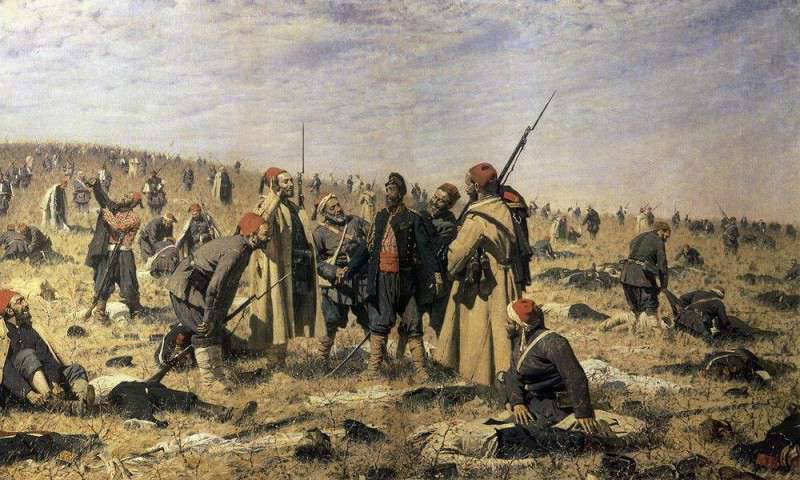
Hardly recovered, Vereshchagin departed to Pleven, where Russian troops were conducting a prolonged siege by the blockaded group of Turkish troops commanded by Osman Pasha. The impressions received here created the basis for a number of very bright works devoted to the Russian-Turkish war. Subsequently, when some of the military accused Vereshchagin of the fact that he allegedly excessively “exaggerated paints”, showing everything through, in their opinion, too tragic a prism, the artist objected that he did not show a tenth of what he saw on his canvases and survived in reality. War 1877 – 1878 painfully reflected not only on the painter himself, leaving a mark in the form of a deep scar, these events affected his entire family. His younger brother Sergey was killed, the other, Alexander, was wounded. Part of the etudes, written literally under the bullets, was lost due to the fault of irresponsible persons whom the artist entrusted to send them to Russia. At the end of the hostilities, the staking officers asked what order he would like to receive for his actual participation in the war, to which the artist responded with an angry tirade. When the information reached him that they were going to award him with a gold sword, Vereshchagin immediately left for Paris.
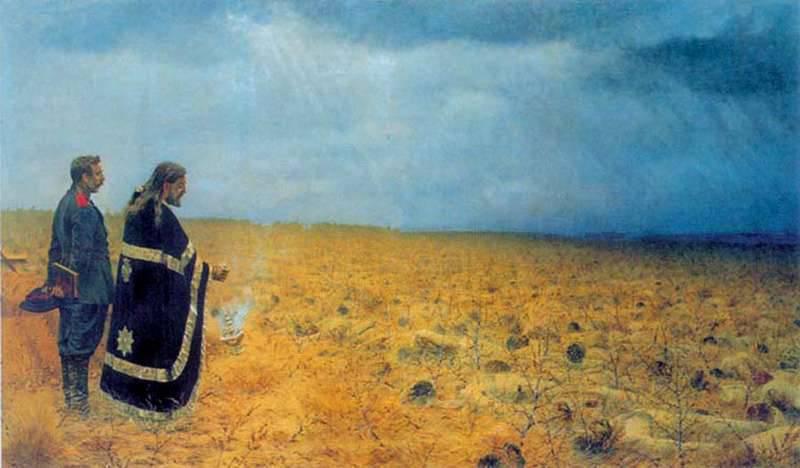
In addition to a set of sketches and sketches, he brought weapons, household items, costumes and ammunition to his Paris workshop. All this provided invaluable assistance in creating paintings. The first exhibitions dedicated to the 1877 – 1878 war. took place at the beginning of the 80's. in Russia, and then in Europe. What he saw did not leave the public indifferent: one - delighted and shocked, some warped and made frown. Vereshchagin was again accused of slandering the image of the Russian army, lack of patriotism and other sins. Not everyone liked the fact that he portrayed the war as it is, and not in the form of pompous rushing in the glory on white horses of generals, decorated with banners. But the audience went to the exhibition. In Europe, Vereshchagin's paintings also caused noise and excitement. For example, in Germany at his exhibitions it was forbidden to lead soldiers and children. Field Marshal Helmut von Moltke, who was in himself a great admirer of Vereshchagin's work and was always one of the first to attend his exhibitions in Germany, ordered only officers to go there. A similar situation exists in the United States, where a ban was also imposed on children visiting the artist’s exhibitions. When Vereshchagin tried to find out why, he was told that his paintings were turning young people away from the war, which is undesirable. Probably, at that time, Vereshchagin's canvases were akin to modern military photography, recording the everyday life of war with an eye to preserving the inexorable evidence of war crimes.
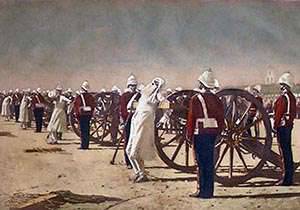
The artist suffered painfully accusations of anti-patriotism and decadence. To restore spiritual balance, he travels a lot: he visited the Middle East, Syria and Palestine. The result was the writing of works on the biblical topic, which led to a conflict with the Catholic Church. Two paintings, the Resurrection of Christ and the Holy Family, were doused with an acid by an overly earnest Catholic monk. These years include the creation of the canvas with the most mysterious fate - "Execution of the leaders of the Sipah uprising by the British", which presents the "enlightened navigators" with not the most humane characters. The picture was bought and disappeared without a trace. Her fate is not known until now.
Again in Russia. The cycle of the Patriotic War 1812 year
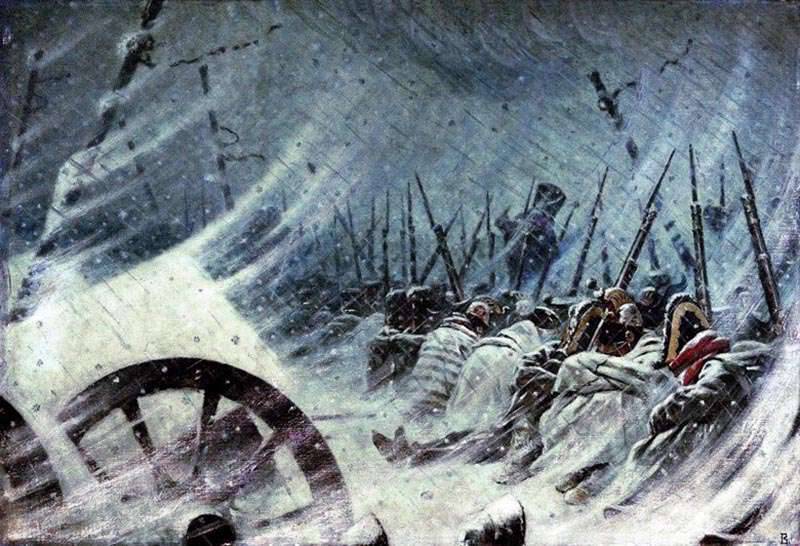
In 1890, Vereshchagin finally returns to his homeland. He bought a house near Moscow, built a workshop there and began to work on the most significant, but unfortunately not fully completed cycle dedicated to the World War 1812 of the year. The creation of paintings was preceded by a long and painstaking research work: reading a lot of books, visiting museums. Visited Vereshchagin and directly on the Borodino field. A lot of attention was given even to small details. Working on the picture "Napoleon in winter dress", Vereshchagin, not stingy, bought an expensive (more than 2 thousand rubles) fur coat trimmed with sable fur. He dressed a janitor in her, in which he had to sweep the yard, chop firewood and perform other economic duties, to the bewilderment of passers-by, surprised by the strange look of an employee in sables. All this was done because, according to the artist, the fur coat, in which, according to the descriptions, the Emperor was dressed, should not be new, but rather shabby.
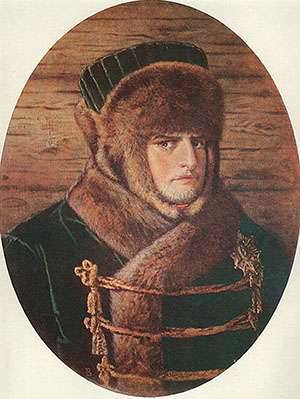
When writing the painting “In the Assumption Cathedral”, the rector of the church was brought to a faint and dizzy state by requesting that horses be placed there for a short time (during the French occupation, cavalry units were quartered in the cathedral). Vasily Vasilyevich was denied a request, I had to write a cathedral from a photograph. In the cycle there are canvases that convey the drama of the winter retreat of the Great Army from Russia. For the realism of the transfer of snow-covered trees, Vereshchagin went to the frozen forest and wrote paints from nature, warming his hands periodically at a divorced campfire. Having conceived a horse with a ripped belly in the foreground of the future “Night Halt of the Great Army”, Vereshchagin carefully consulted a veterinarian, but the impressionable spouse dissuaded the artist from excessive naturalism, and the horse was replaced by a gun.
The appearance of the epic of the Patriotic War also caused a nervous reaction, primarily from the higher strata of society. Traditionally, the French aristocracy, against the background of the military union practically imposed by France, was unhappy with how the Emperor and the French themselves are depicted in the paintings. Despite the fact that Napoleon’s clothes were documented, she was called “stupid” in the official press, and the executions of Muscovites in the Kremlin and the stables in the cathedral were too tendentious. As if the Napoleonic army arrived in Russia exclusively for scientific and educational purposes! Of course, in the opinion of notable persons, it was not long ago that they were hardly explained in Russian, so the French simply could not behave. Painted on huge canvases, intended primarily for display in large premises, the paintings of the epic of World War II were not bought by patrons of art because of the inconvenience of their placement. Only on the eve of the anniversary of “Thunderstorm of the Twelfth Year”, after the artist’s death, they were acquired by Nicholas II.
At the turn of the century, the artist visited the Philippine Islands, the United States and Cuba, where, hot on the heels of the recent Spanish-American war, he created a number of works, the most famous of which were In the Hospital, Letter to the Motherland and others. On the eve of the Russian-Japanese war, Vereshchagin was on a trip to Japan. Due to the rapidly deteriorating situation, in order not to fall into the number of internees, at the end of 1903, he returned to Russia. When the fighting began, the artist, as has happened more than once, left the family and went to Port Arthur. 31 March 1904 of the year 62-year-old Vereshchagin was aboard the squadron battleship Petropavlovsk, along with Vice Admiral S. O. Makarov, whom he knew from the Russian-Turkish war. Among the rescued from the ship of the famous battle-painter was not.
The war that Vereshchagin so long and consistently exposed and exposed in his canvases throughout his life, reached him. The canvases of the military man and the artist Vasily Vasilyevich Vereshchagin are a reminder that “the continuation of politics by other means” is not only the victorious sound of fanfare and ceremonial uniforms with aglets, that all this is preceded by blood and suffering. As forty years later, 23-year-old poet and soldier Mikhail Kulchitsky, who now rests in a mass grave in the Luhansk region, writes in his last verses: “War is not a firework at all, but simply a difficult job, when the infantry is black from sweat” .
Information